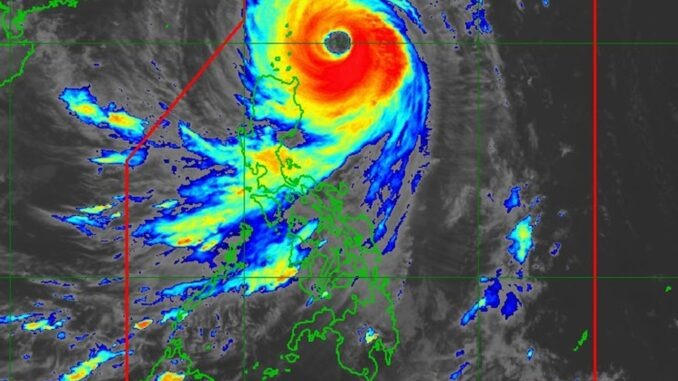
Ameteorologist has pointed out the sheer size of Typhoon Kong-rey’s eye as the massive storm approached Taiwan on Wednesday.
As of Wednesday afternoon, Typhoon Kong-rey had maximum sustained winds of 130 mph, according to the website Zoom Earth. The storm has weakened slightly since Tuesday night, when it was categorized as a super typhoon with maximum sustained winds of 150 mph, equivalent to a Category 4 hurricane. Forecasts anticipate that Typhoon Kong-rey will weaken further by the time it makes landfall in Kaohsiung in the early morning hours on Thursday.
On Tuesday night, meteorologist Noah Bergren of TV station WOFL in Orlando, Florida, commented on the size of the storm’s eye.
“Super Typhoon Kong-rey is easily one of the largest eye’s in a major tropical system you will ever see on Earth,” Bergren posted on X (formerly Twitter). “Thing is absolutely massive.”
A wave crashes outside of Fugang Harbor in Taitung, Taiwan, ahead of Typhoon Kong-rey on Wednesday. The storm is expected to make landfall in Taiwan early Thursday morning. Annabelle Chih/Getty
AccuWeather senior meteorologist Alan Reppert told Newsweek that having a large eye doesn’t necessarily imply anything about the storm’s strength.
“It just means the winds with it are farther away from the center than if it was a smaller eye,” he said. “It doesn’t necessarily have any major defining characteristic of the storm.”
Reppert added that a stronger storm that’s been around longer usually has a wider eye than a newer storm.
Most spaghetti models—or computer models illustrating potential storm paths—show Kong-rey making landfall on Taiwan’s southeast coast and cutting across the island before emerging with maximum sustained winds of around 75 mph. Models indicate that the typhoon will exhibit a northeastern turn away from China, which will take it out to the East China Sea.
Kong-rey’s strength is uncharacteristic for this time of year, The New York Times reported, adding that the typhoon is expected to make landfall equivalent to a Category 4 hurricane.
Reppert warned that strong winds up to 140 mph with higher gusts could hit southern Taiwan, though the storm is expected to weaken as it moves over the island. An AccuWeather report warned of “significant structural damage, mudslides and landslides” from the storm, as up to 3 feet of rain is expected to lash Taiwan. The storm could either maintain its intensity or strengthen before it makes landfall early Thursday.
Eastern China and Japan also are expecting heavy rain as the storm progresses.
A typhoon is classified as a severe tropical cyclone occurring in the Northwest Pacific. A hurricane is the term for the same type of storm in the Northeast Pacific and Northern Atlantic. Outside of these regions, the storms are called tropical cyclones.
MY LATE GRANDMA’S NEIGHBOR ACCUSED ME OF HIDING “HER SHARE OF THE WILL” — WHEN SHE REFUSED TO LEAVE, I GAVE HER A REALITY CHECK.

The morning sun, usually a welcome sight, cast harsh shadows on the woman standing on my porch, her face a mask of indignation. Mrs. Gable, Grandma’s “entitled neighbor,” as she so lovingly referred to her, was a force of nature, and not a particularly pleasant one.
“How long am I supposed to wait for my share of the will?!” she demanded, her voice a grating rasp that could curdle milk. “My grandkids are coming over, and I want them to take their part of the inheritance before they leave!”
I blinked, trying to process the sheer audacity of her statement. “Mrs. Gable,” I said, my voice calm despite the rising tide of annoyance, “Grandma’s will… it doesn’t mention you.”
Her eyes widened, then narrowed into slits. “Nonsense! We were like family! She wouldn’t leave me out.”
“I’m sorry,” I said, “but everything in the house now belongs to me.”
I offered a small concession. “I’ve packed some boxes for donation. You’re welcome to look through them, see if there’s anything you want.”
“Donation boxes?!” she shrieked. “Your grandma was like family to us! We had to be mentioned in the will. Give it to me! I have to see for myself.”
“I can’t do that,” I said, my patience wearing thin. “The will is a legal document.”
She planted her feet, a stubborn look on her face. “Then I’m not leaving. I’ll just stand here until you give me what’s mine.” She proceeded to stand directly in front of my porch, peering into my windows and muttering under her breath.
I sighed. This was getting ridiculous. I needed to give this woman a reality check, a gentle but firm reminder that she wasn’t entitled to anything.
I went inside, grabbed a pen and a scrap of paper, and returned to the porch. Mrs. Gable watched me, her eyes filled with suspicion.
“What’s that?” she asked, her voice laced with distrust.
“I’m writing you a bill,” I said, my voice deliberately casual.
“A bill? For what?”
“For services rendered,” I said, scribbling on the paper. “Let’s see… ‘Consultation regarding inheritance, one hour… $100.'”
Mrs. Gable’s face turned a shade of purple I didn’t think possible. “Are you serious?!”
“Perfectly,” I said, adding another line. “‘Unauthorized surveillance of private property, one hour… $50.'”
“That’s outrageous!” she sputtered.
“And,” I continued, adding a final line, “‘Emotional distress caused by unwarranted demands, one hour… $150.'” I handed her the paper. “That’ll be $300, Mrs. Gable.”
She snatched the paper from my hand, her eyes scanning the ludicrous list. “You can’t do this!”
“Actually, I can,” I said, a smile playing on my lips. “And if you don’t pay, I’ll have to add late fees.”
She crumpled the paper in her fist, her face a mask of fury. “You’re just like your grandma!” she hissed. “Entitled and selfish!”
“Perhaps,” I said, “but I’m also practical. And I value my peace of mind.”
She glared at me for a moment, then turned and stomped off the porch, muttering about lawyers and lawsuits. I watched her go, a sense of satisfaction washing over me.
Later that day, as I sorted through Grandma’s belongings, I found a small, velvet-lined box tucked away in a drawer. Inside was a handwritten note, addressed to me.
“My dearest grandchild,” it read, “I know Mrs. Gable can be… persistent. Remember, you owe no one anything. Your happiness is your own. And sometimes, a little bit of absurdity is the best way to deal with entitlement.”
I smiled, a warm feeling spreading through my chest. Grandma had known exactly what to do. And she had left me the perfect tool to handle it. I had learned a valuable lesson that day: sometimes, the best way to deal with entitled people is to meet their absurdity with your own. And a little bit of humor never hurts.



Leave a Reply